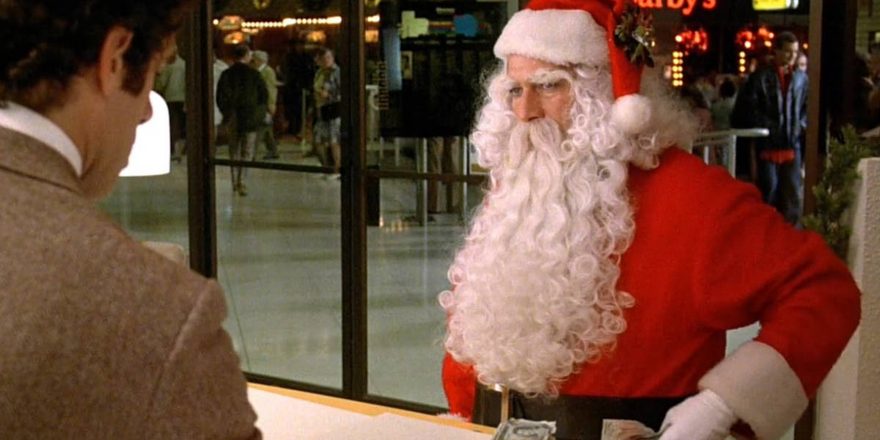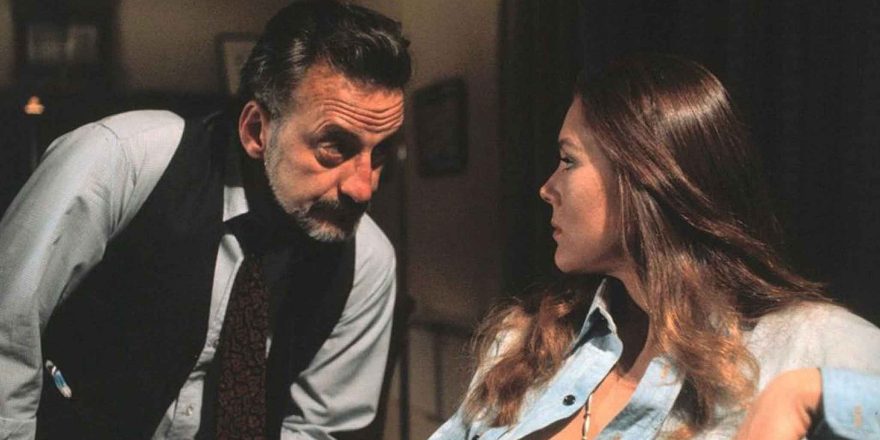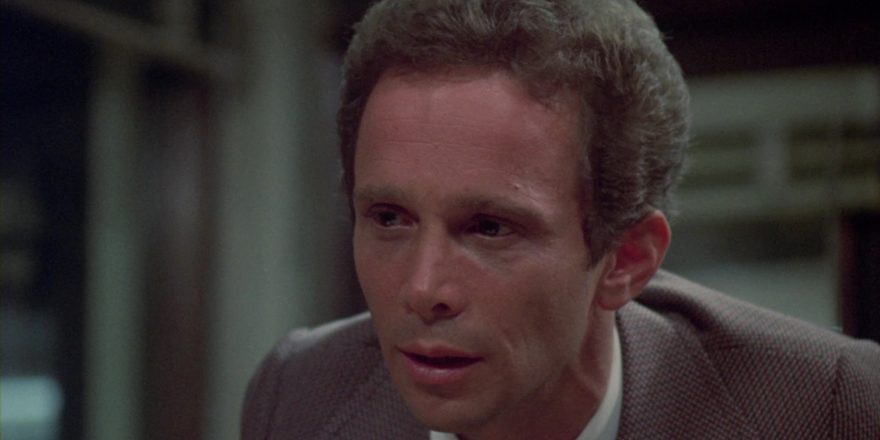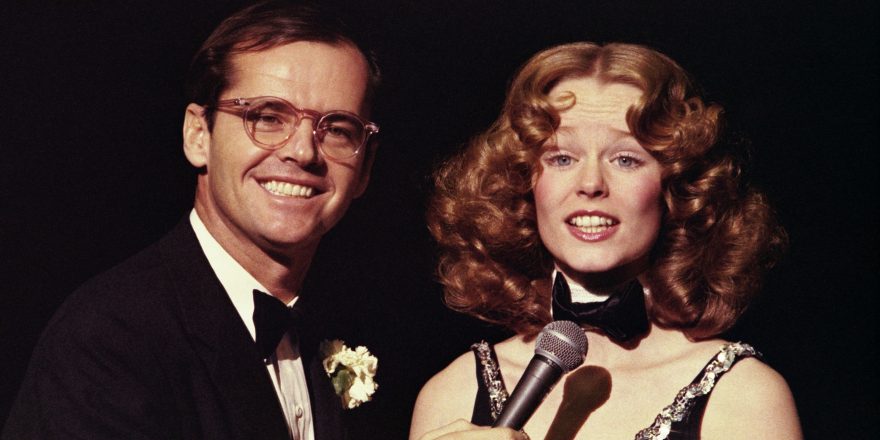Weary of the prospect of dutifully sitting through Capra’s It’s a Wonderful Life or Henry Koster’s The Bishop’s Wife for the umpteenth time? Dubious of the appeal of half-watching Home Alone yet again in a medicated state out of sheer force of habit? Then why not check out The Silent Partner, a seventies Canadian Christmas noir that manages to be both romantic and chilling, set against the backdrop – at least for the first half – of the Yuletide season? The murder, mayhem, and unexpected plot twists just might lift your spirits more than the usual, played-out holiday fare, and you can never go wrong with a psycho-Santa.
The Silent Partner, directed by the great Canadian journeyman director Daryl Duke (Payday, I Heard the Owl Call My Name), was one of the most successful movies to come out of the Canadian film industry’s infamous tax shelter era between 1975 and 1982 (Cronenberg emerged from the same soup), a film-production incentive program that allowed investors to deduct 100 percent of their investment from their taxable income. This eventually led investors to figure out that not releasing the films could be more profitable for them than releasing them, so the worse (read: more unreleasable) the film was, the more money it was apt to make. (According to this formula, investors no doubt figured they would make a windfall with such lurid Cronenberg shockers as Rabid, Shivers and The Brood, which ironically actually ending up becoming international moneymakers). When it was revealed that in 1980 half the films produced never even made it to theaters (there were about 345 tax-shelter films made in the era), the incentive was summarily downgraded to 50 percent, but not before producing a major cluster of pretty impressively bad films, and, with Black Christmas, My Bloody Valentine and Prom Night, unwittingly laying the groundwork for the B-movie slasher film to become a future blockbuster genre. Exploitation and B films starring out-of-work or second-tier Hollywood stars were the order of the day, often featuring stories without any particular Canadian identity.
There were a number of prestige Canadian pictures that also emerged from the tax-shelter dynasty: Murder By Decree, The Grey Fox, Atlantic City and/or, depending on your definition of “prestige,” Meatballs and Porky’s, to name a few. Not the least of these was The Silent Partner, a movie that deftly threaded the needle between prestige and exploitation, even throwing in a little dash of slash for good measure. The film boasted impeccable international credentials (the cinematographer, Billy Williams, shot Women in Love, Sunday, Bloody Sunday, and the Iraq sequence of The Exorcist), including A-list stars Elliott Gould and a ravishing Susannah York (whom Williams also made look so gorgeous opposite Elizabeth Taylor in X, Y and Zee). The inspired casting of Christopher Plummer as the third lead helped satisfy above-the-line Canadian talent requirements as well, providing the actor with a juicy part far removed from his most famous role as Captain Von Trapp in the syrupy The Sound of Music (which he was fond of calling “S&M”). Famous jazz musician Oscar Peterson composed the score, his music adding a lush romanticism to the film, and emerging screenwriter and director Curtis Hanson, who would later make L.A. Confidential and Wonder Boys, wrote and produced the movie. (After Duke balked at including a beheading scene, Hanson was called in for a final week of pick-ups, and he also completed the film himself in post.)
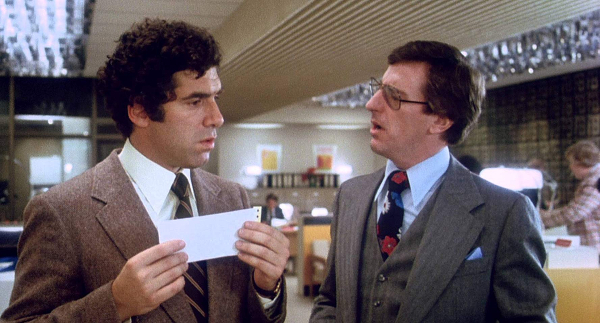
The Silent Partner is particularly notable for its extensive use of recognizable Toronto locations and landmarks, circa 1978. For those of us who remember the city fondly as it was, before becoming the vapid site of endless, unimaginative, instantly redundant glass-tower condos, the film acts both as a tonic and as a valuable document of a bygone era. The film opens in the Eaton Centre, a vast, layered shopping mall, whose design was considered “revolutionary” at the time, which opened with much fanfare in 1977. With its open-concept, multiple-leveled interior and high-vaulted ceilings (inspired, it was loftily claimed, by the Galleria Vittorio Emanuele II in Milan), it attracted throngs of visitors and became a major hub of the city. The opening shot pans down from the exterior of the landmark mall, dissolving to the credits over interior shots of the famous vaulted ceilings beneath which numerous Santas mix with patrons busy with their Christmas shopping as a band plays “Joy to the World.” We are introduced to Elliott Gould as Miles Cullen, a somewhat hapless bank teller who works at the First Toronto Bank. His philandering boss asks Miles to take out his mistress, Julie Carver (Susannah York), a fellow employee, whom he plans to rendezvous with later, for a drink while he makes excuses with his wife at home. Miles, an avid aquarist, takes her along to a store that sells tropical fish to pick up his long-awaited Caribbean Angelfish, introducing an enjoyably over-determined plot device and metaphor involving his aquarium. Miles takes the fish along to the bar in a plastic bag, making small talk with Julie as she waits for her real date to arrive. When Miles expresses concern over her affair with their unctuous boss, Julie asks him if he is criticizing her for what she is doing or for whom she’s doing it with, establishing her as a rather lost soul who nonetheless has her own agency. When the boss finally arrives, Miles, who has been upbraided by her for being morally judgey, goes home alone with “his date,” the Angelfish, forlornly holding it while riding on the subway. The movie is punctuated with these small character touches, lending it a kind of novelistic texture. (Hanson adapted the screenplay from the novel Think of a Number.)
Coming off a string of film successes in the early seventies, including three with Robert Altman (M*A*S*H, The Long Goodbye, California Split), Elliott Gould is at his most charming in The Silent Partner, playing the everyman forced by unexpected circumstances to dig into hitherto untapped resources in order to survive. Disguised as one of the mall Santas, Harry Reikle (Plummer) has been doing reconnaissance on the bank where Miles works, intending to rob it immediately after a rich businessman makes his hefty daily deposit. On his first attempt, he is spooked by the antics of an obnoxious child and flees the bank, but not before having written a note on a carbon deposit slip saying that he has a gun and to give him all the cash. While drawing a heart on a deposit slip for Julie, Miles notices the imprint of the thief’s discarded note on the carbon, tipping him off to his plans. When he later notices that the “G” in the note is written exactly the same way as the “G” in a particular mall Santa’s sign (which, ironically, says “Give Give Give to those less fortunate”), he has identified the thief and a plan emerges. The next day, nerdy Miles brings a Superman lunch pail to work (another one of those lovely ironic touches), and after the businessman makes his big deposit of close to 50 gees, Miles puts the money into it and conceals it under the counter. When Harry, disguised as Santa, comes in to carry out the heist and hands Miles the note, Miles opens his register to reveal a much smaller amount of money. “I saw him give you the deposit. Give me the money, you fucker,” says Harry menacingly, but Harry trips the alarm by pulling out a hundred dollar bill, which also causes a surveillance camera to start filming. Harry flees, and after he has a shootout with the security guard in the crowded mall, he escapes in a stolen car. Miles tells everyone that the thief escaped with the big deposit, clearing the way for him to take home the lunch pail stuffed with money, and setting off a series of increasingly treacherous events, a cat-and-mouse game between thieves.
Along with its ingenious plot, what sets The Silent Partner apart is its deft characterizations and fine performances. Susannah York makes the most of a slightly underwritten and confused role by imbuing it with her usual damaged sophistication. Often playing characters on the verge of madness, her persona might be best described as the masochist that tends to top from the bottom (The Killing of Sister George, They Shoot Horses, Don’t They, The Maids, Altman’s Images). She can also go from frigid to nymphomaniacal in 60 seconds, often displaying an unregulated sexuality as the mistress or the lesbian lover, slightly corrupt and always kinky. “Don’t let your emotions run away with you,” she deadpans to Miles after he gives her a weak kiss under the mistletoe at the bank, suggesting she wants exactly the opposite. But it’s really Plummer who steals the show. He had played unsavory, sadistic characters before (most notably in Inside Daisy Clover), but here he outdoes himself, turning a potentially stock villain into a cornucopia of perversions. After the failed bank robbery, we follow him to The Silver Dollar Room (another Toronto landmark, recently defunct), a notoriously seedy bar, and to a sauna, where he viciously beats a topless young hooker and slowly smashes in her bloody face with his foot, thoroughly establishing his psycho credentials. This scene is intercut with shots of Miles at home rolling up the purloined money in checkered tea towels, his dainty, domestic criminality set in stark contrast to Harry’s violent psychopathy and misogyny. The two characters are paralleled throughout as two sides of the same coin, as if Harry were the monstrous embodiment of Miles’ repressed id, his corrupt alter ego.
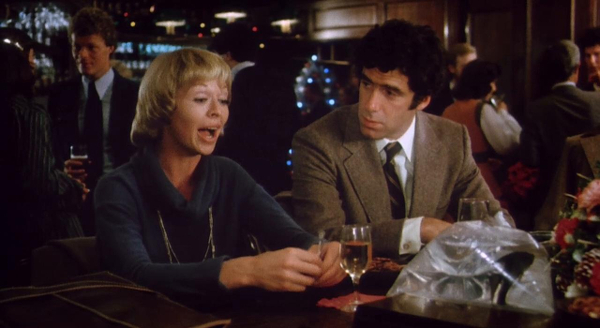
The next day, Miles puts the money wrapped in the tea towels into a safety deposit box at his bank, then returns home and hides the key in a jar of black currant jelly in the refrigerator. He visits his father in a retirement home to give him a Christmas present, but the old man is blank and unresponsive, further establishing Miles’ loneliness and his desire for something more than a dead-end life. Miles’s boss cuckolds him into taking Julie to his Christmas party in order to divert his wife’s suspicions about his mistress. At the party, Miles catches a female fellow bank employee, a ditzy blonde earlier seen wearing a tight T-shirt that says “Bankers do it with interest,” having sex in the bathroom with a colleague other than her drunken fiancé (an underutilized John Candy, before he was famous, who also works at the bank). The party scenes sets up the louche sexual office politics of the era, so different from today, wherein fellow workers indulge in sordid affairs, deception, betrayal and lust as a way of coping with the everyday drudgery of the workplace. As Miles drives Julie home in his convertible sports car, the wind blows the roof back when he goes too fast, a nice bit of foreshadowing for the following scenes in which the roof really blows off for Miles. Back at his apartment, Julie looks into the aquarium, her face mirrored in it as a loaded metaphor – the duplicitous femme fatale, the conflicted woman, and further foreshadowing of the carnage to come. Miles’ lovemaking to Julie is interrupted by a phone call from Harry, who tells him to “think of a number” – 48,350 – the amount he has stolen from than bank, and, in effect, from Harry. Harry tells him, “You’re doing to her what you did to me,” i.e. fucking him. This exchange establishes the essential sexual subtext of the film, the implied homoerotic link between Miles and his dissolute, vaguely bisexual “silent partner,” his repressed id – greedy, criminal, amoral, sexually violent – released by the pleasure he feels from his complicity in the theft. Plummer brilliantly plays his character as vaguely bisexual with a hint of femininity, with his gold neck chain and black mesh shirt, manicured, blow-dried, and looking like he may be wearing too much male base.
Julie interprets Miles’ sudden distraction as either impotency or moral prudery, and asks Miles to drive her home. When Miles returns to his quintessentially Toronto apartment, a shaky POV shot of its exterior suggests that someone is watching him. Miles gets another phone call from Harry, who, as Miles sees when he goes to the window, is standing at a phone booth down below. Miles barricades the door and waits in anticipation until suddenly the letter slot flies opens, a slow zoom in revealing Harry’s eyes (a moment brilliantly exploited in the trailers and promos for the film). Harry starts calling Miles at the bank, and the next time he comes home from work, his apartment has been trashed, and his Angelfish has been violently pinned to the wall with the blade of a kitchen knife (the fish representing Miles’ authentic, civilized self, as well as his previous solitude). Harry calls him once again from the phone booth, but when Miles tells him to come up, Harry enters the apartment only to hear the phone ringing. He picks it up and hears Miles’ voice on the other end telling him to go to the window, and when he looks down, Miles is at the phone booth, their roles now literally reversed. “It’s me. Go fuck yourself,” Miles tells him, the two characters ingeniously mirrored in similar configurations from this point on. Subsequently, Miles steals a delivery van and pins it on Harry, who ends up in a police lineup for the crime, and is then arrested for his previous assault and rape of a teenager. (“What’ll happen to him?” Miles asks a cop, who replies, “Not enough.”) On Christmas Eve, after the office party, Miles asks Julie over for a drink, but she makes it clear she thinks they should remain only colleagues, and at the halfway point of the movie, the Christmas segment ends.
The second half of the movie begins the following summer at the funeral of Miles’ father. Elaine (Celine Lomez), a young woman who claims to have worked at his father’s retirement home, introduces herself to Miles. Elaine now replaces Julie as the main female love interest of the story, almost as if she is her alter ego, a classic noir femme fatale – duplicitous, conflicted, and dangerous. As it turns out, she is not who she says she is at all, but rather Harry’s moll whom he has sent to seduce Miles in order to find out the whereabouts of the stolen cash. (She in fact works as a cocktail waitress at the Silver Dollar Room.) Miles romances her at several classic seventies Toronto locations (including one of its long defunct harbor-boat restaurants) before inviting her to the wedding of the John Candy character and his blonde fiancée, who had previously had sex in the bathroom with a colleague at the boss’ Christmas party. As it turns out, the bride is pregnant from that encounter, a fact that only Miles knows, another instance of duplicity and things not being what they appear interwoven into the plot. Miles ends up having sex with Elaine even though he has already figured out she never worked at his father’s nursing home and that she has been sent as Harry’s proxy. The fact that Miles and Harry are now having sex with the same girl binds them even further in homoerotic conspiracy. Becoming increasingly more like his alter ego, Miles now hatches a scheme with Elaine to gain access to the money in the safety deposit box at his bank. (His maid had earlier thrown out the jar of jelly in which Miles had hidden the key.) Elaine shows up at the bank in “female drag” – dressed as a rich, glamorous woman with a curly wig and tinted glasses – to claim she had lost the key to her box and demand they have it opened by a locksmith. Elaine tries to take the money with her, but Miles forces her to put it back in the box. Fearing that Julie will recognize Elaine from the aforementioned wedding, Miles kisses her passionately when she returns from lunch, allowing Julie to exit unnoticed, confusing Julie about where exactly she stands romantically with him.) Afterwards, at dinner, Miles tells Elaine, “I find myself doing things I never dreamed I was capable of,” as he smokes a cigar, the good guy now taking pleasure in his criminal role in classic noir fashion. He gives her the key to the box to cement their relationship, which she puts down her décolletage, as any femme fatale worth her salt would do.
Harry, of course, has suddenly been released from prison, and the finale of the movie is set in motion. When she goes to the ladies’ room at dinner after Miles has given her the key, Harry snatches Elaine and takes her back to Miles’ apartment. Elaine tells him she’s with Miles now, and rubs it in that she’s fucking him, provoking Harry to dunk her head in the fish tank, and when the glass breaks, he saws her head off with the jagged edge of the glass. Miles comes home to find Elaine’s head in the fish tank, the aquarium metaphor extended to its gruesome conclusion. Miles is left to dispose of the head and body (injuring his leg in the process), which he eventually deposits into the concrete foundation of the brand new First Toronto Bank that is under construction, a perfect metaphor, as it turns out, for the future horror show of the city’s unrelenting high-rise development. Julie has left the key to the deposit box for Miles to find on the chessboard (another extended metaphor in the film), setting the stage for the thrilling finale.
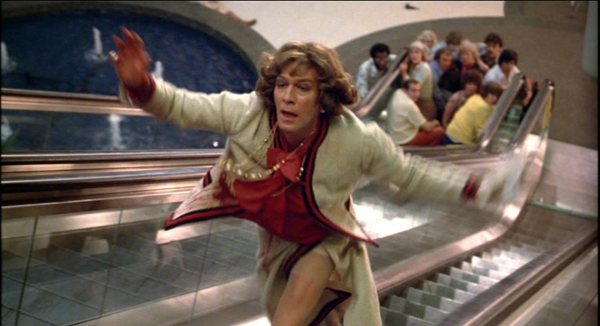
In the climactic sequence, Harry returns to the bank, the scene of the original crime, this time not disguised as Santa, but in female drag, just as Elaine had done earlier. Dressed in a beige skirt suit and wearing a brown, feminine wig, Plummer’s entrance down the escalator is flawless as he inhabits the female role with obvious relish. Harry has already told Miles that he will be coming to collect the stolen money, but his appearance in drag shocks Miles. It’s as if Harry’s malevolent repressed homosexuality, and by extension, the homoerotic tension between him and Miles that has been building throughout the film, has now been externalized and made real through his transformation into a woman. Plummer plays it to the hilt, remarkably staying in effeminate character until the bitter end, right up until his death. It’s as if he has actually transformed into his own twisted female alter ego, like Norman Bates at the end of Psycho. Miles trips the alarm, causing Harry to shoot him and flee the bank, but not before being shot himself by the security guard, the two paralleled once again. A bloody mess, Harry runs grotesquely in high heels up the down escalator, but falls back to the bottom. Before dying, he tries to implicate Miles in the crime by whispering to the security guard, but it’s too late. Miles, who has also been shot, sees Harry dead in drag, his legs splayed open, at the bottom of the other escalator as he’s being taken away on a gurney. In the last scene, Julie joins Miles in the ambulance, Toronto’s trademark CN Tower, built only four years earlier, looming in the background. Julie has figured out the crime, and she is more than willing to go into exile with Miles to some tropical paradise with the stolen loot. The good girl has replaced by the bad femme fatale, Miles’ homosexual alter ego has been destroyed, and heterosexual normalcy, as it generally is in the movies, has been conveniently restored.



